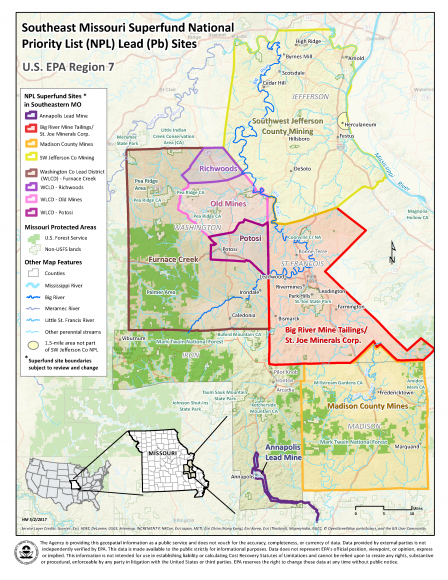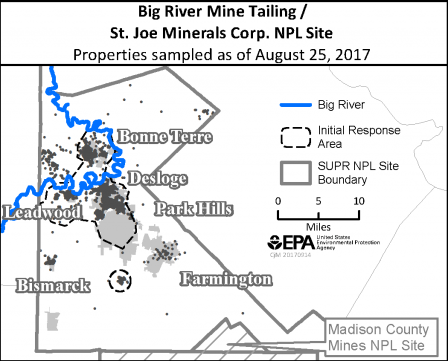Big River Mine Tailings/St. Joe Minerals Corp. National Priorities List (NPL) Superfund Site, St. Francois County, Missouri - Fact Sheet, August 2018
EPA Proposes Plan for Early Interim Remedial Action for Big River and Floodplain in St. Francois County
INTRODUCTION
The U.S. Environmental Protection Agency (EPA) Region 7 hosted a Public Meeting, and is soliciting public input on the Proposed Plan for Early Interim Remedial Action to address lead contamination in stream sediment in the Big River, and in floodplain soil within the Big River watershed, Operable Unit 2 (OU2) in St. Francois County at the Big River Mine Tailings/St. Joe Minerals Corp. National Priorities List (NPL) Superfund Site (site). Public comments on the Proposed Plan will now be accepted through Thursday, Sept. 27, 2018.
6:00 to 8:00 p.m.
Mineral Area College, North College Building
112 Dixie Kohn Drive
Park Hills, MO 63601
The Proposed Plan for Early Interim Remedial Action includes the cleanup of heavy metals-contaminated mining wastes, soil, and sediment. For additional information regarding the Proposed Early Interim Remedial Action, these and other documents are available in the site Administrative Record at www.epa.gov/superfund/bigrivermine. Click on “Site Documents and Data,” then “Administrative Records,” and then “Big River Mine Tailings OU2.” EPA has assessed the ability of the public to access site information through an internet-based repository, and has determined that the local community has this ability.
 Figure 1: Southeast Missouri Superfund NPL Lead Sites - click to enlargeDocuments are also available for public review at following locations:
Figure 1: Southeast Missouri Superfund NPL Lead Sites - click to enlargeDocuments are also available for public review at following locations:11201 Renner Boulevard
Lenexa, KS 66219
Hours: Mon-Fri, 8 a.m. to 5 p.m.
Toll-free: 1-800-223-0425
1025 West Main St.
Park Hills, MO 63601
Hours: Mon-Fri, 8 a.m. to 4 p.m.
Phone: 573-431-1947
Community Engagement Specialist
U.S. EPA Region 7
11201 Renner Boulevard
Lenexa, KS 66219
Phone: 913-551-7186
Toll-free: 1-800-223-0425
Email: kramer.elizabeth@epa.gov
This site resides within the Old Lead Belt, which was one of the world’s largest lead mining districts where mining began in the early 1700s and produced more than 9 million tons of lead. (See Figure 1 above.) It has been estimated that some 250 million tons of hazardous mining waste (such as lead mill waste tailings and chat) was generated in the Old Lead Belt from processing lead.
Historical mining activities in St. Francois County released hazardous heavy metals, including lead, cadmium and zinc, contaminating soil, sediment, surface water, and groundwater. Lead mine waste has been dispersed throughout the area from water and wind erosion, and spread as residential fill material, treatment on icy roads, and agricultural lime. Runoff from these applications, along with historic releases directly from the mine waste piles, has been transported downstream in the Big River and spread along the floodplain. EPA and Missouri state agencies have been addressing lead-contaminated soils in this county for over three decades.
PROPOSED PLAN OVERVIEW
The Proposed Plan sets forth the remedial alternatives and presents EPA’s preferred initial approach to address OU2, non-residential floodplain soil and stream sediment in the Big River, from the Eaton Creek confluence near Leadwood, moving downstream to the confluence with Mill Creek (approximately 37 river miles). OU2 also includes lead-contaminated sediment and floodplain soils in Flat River Creek from the Elvins tailings site to the downstream confluence with the Big River (approximately 6 river miles). Alternative 2: Focused Removal and Stabilization at Seven Candidate Locations with Continued Removal and Adaptive Management is preferred over the other alternatives presented by EPA, based on the National Contingency Plan threshold and balancing criteria.
 Figure 2: Location of site - click to enlargeEPA proposes to first address floodplain soil and sediment in the upper reaches of the site to prevent continued downstream migration and expedite cleanup in locations posing the greatest and most immediate threats to human health and the environment. The early interim remedial action approach will allow EPA to study the effects of proposed technologies on the overall stability and function of the Big River Watershed. The iterative nature of the early interim approach will include removal and stabilization of some the most highly contaminated areas of the river and floodplain, while assessing any unintended impacts to its dynamic system. Additional remedial actions at the site, including the Doe Run Pile and areas further downstream, will be addressed under future decision and response actions.
Figure 2: Location of site - click to enlargeEPA proposes to first address floodplain soil and sediment in the upper reaches of the site to prevent continued downstream migration and expedite cleanup in locations posing the greatest and most immediate threats to human health and the environment. The early interim remedial action approach will allow EPA to study the effects of proposed technologies on the overall stability and function of the Big River Watershed. The iterative nature of the early interim approach will include removal and stabilization of some the most highly contaminated areas of the river and floodplain, while assessing any unintended impacts to its dynamic system. Additional remedial actions at the site, including the Doe Run Pile and areas further downstream, will be addressed under future decision and response actions.
The need for further action to achieve the cleanup goals will be determined through monitoring of the early interim remedial actions. Riverbank removal will be avoided in areas where stable, existing riparian vegetation and bank toes exist, which are not projected to erode and contribute as ongoing sources of contamination. Monitoring throughout the response actions will assist in determining the most effective technologies for cleanup, and will be incorporated under the final remedial actions for OU2.
ABOUT LEAD AND PUBLIC HEALTH
Lead exposure can cause a range of adverse health effects, from lifelong behavioral disorders and learning disabilities to seizures and death, putting young children at the greatest risk because their nervous systems are still developing.
Lead is a toxic metal that is harmful if inhaled or swallowed. Lead is classified by EPA as a probable human carcinogen, and is a cumulative toxicant. Lead exposure can pose serious health risks, particularly for young children 7 years old and younger, pregnant women, and nursing mothers. Pregnant women and nursing mothers should avoid exposure to lead to protect their children.
Lead is particularly dangerous to children because their growing bodies absorb more lead than adults do, and their developing brains and nervous systems are more sensitive to the damaging effects of lead. Babies and young children can also be more highly exposed to lead, because they often put their hands and other objects into their mouths that can have lead from dust or soil on them.
-
Nervous system and kidney damage
- Learning disabilities, attention-deficit disorder, and decreased intelligence
- Speech, language, and behavior problems
- Poor muscle coordination
- Decreased muscle and bone growth, and hearing damage
-
Harm to a developing fetus
- Increased chance of high blood pressure during pregnancy
- Fertility problems (in men and women)
- High blood pressure
- Digestive problems, nerve disorders, memory and concentration problems, and muscle and joint pain
LEAD TESTING
The only way to know if your child has elevated blood lead levels is to have his or her blood tested. EPA encourages parents to have their children tested for lead exposure. Talk to your pediatrician, general physician, or local health department about what you can do and about testing your child. Your doctor can do a simple blood test to check you or your child for lead exposure. For lead testing for children, contact the St. Francois County Health Center, 1025 West Main Street, Park Hills, Missouri; phone: 573-431-1947.
Also, talk with EPA (see contacts below) about testing your residential yard and/or private (drinking water) well at no cost to the property owner.
PROTECT YOUR FAMILY FROM LEAD
-
Washing hands after playing outside and before meals
- Eating a diet high in calcium and iron (and low in fat)
- Regularly cleaning floors, window sills, and other surfaces. Use a mop or sponge with warm water and general all-purpose cleaner. Thoroughly rinse sponges and mop heads often during cleaning of dirty or dusty areas, and again afterward.
- Regularly washing children’s hands, bottles, pacifiers, stuffed animals, and toys. Keep play areas clean.
- Removing shoes or wiping soil from shoes before entering your home to avoid tracking in lead from soil.
- Make sure children avoid fatty (or high fat) foods and eat nutritious meals high in iron and calcium. Children with good diets absorb less lead.
FOR ADDITIONAL LEAD AND SITE INFORMATION
- EPA's Lead page
- EPA's Learn About Lead page
- EPA's Lead at Superfund Sites page
- EPA's Fight Lead Poisoning with a Healthy Diet page
- Lead ToxFAQs™ - Agency for Toxic Substances & Disease Registry (ATSDR)
- Lead page - ATSDR's Toxic Substances Portal
- EPA Fact Sheets for Missouri cleanup sites are available online
INFORMATION REPOSITORY AND ADMINISTRATIVE RECORD
An Information Repository and Administrative Record were established for the Big River Mine Tailings/St. Joe Minerals NPL Superfund Site, which contain site-related documents and are available for review at www.epa.gov/superfund/bigrivermine.
TECHNICAL ASSISTANCE GRANT
In an effort to help affected communities understand the technical information related to a Superfund site, EPA has established a Technical Assistance Grant (TAG) Program. The program provides up to $50,000 for a qualified citizens’ group to hire an independent technical advisor. The advisor can assist citizens in their interpretation of technical data, site hazards, and the different scientific technologies used to support site actions. (For more information, see EPA contacts below.)
EPA CONTACT INFORMATION
If you have questions about this Fact Sheet, need additional information about the site, and/or would like to receive site updates, please contact EPA:
Community Engagement Specialist
U.S. EPA Region 7
11201 Renner Boulevard
Lenexa, KS 66219
Phone: 913-551-7186
Toll-free: 1-800-223-0425
Email: kramer.elizabeth@epa.gov
Lenexa, KS 66219
